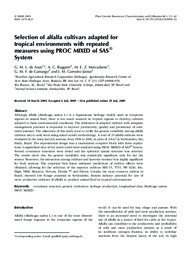Selection of alfafa cultivars adapted for tropical environments with repeated measures using PROC MIXED of SAS system.
Selection of alfafa cultivars adapted for tropical environments with repeated measures using PROC MIXED of SAS system.
Autoria: ASSIS, G. M. L. de; RUGGIERI, A. C.; MERCADANTE, M. E. Z.; CAMARGO, G. M. F. de; CARNEIRO JUNIOR, J. M.
Resumo: Although alfalfa (Medicago sativa L.) is a leguminous herbage widely used in temperate regions as animal feed, there is not much research in tropical regions to develop cultivars adapted to these environmental conditions. The utilization of adapted cultivars with adequate management practices is important to improve productivity, quality and persistence of cultivated pastures. The objectives of this study were to verify the genetic variability among alfalfa cultivars and to rank them using mixed model methodology. A total of 35 alfalfa cultivars were evaluated in the rainy and dry seasons, from 1996 to 2000, in plots of 2.8 m2 in Sertãozinho, São Paulo, Brazil. The experimental design was a randomized complete block with three replications. Longitudinal data of dry matter yield were analyzed using PROC MIXED of SAS® System. Several covariance structures were tested and the spherical spatial structure was selected. The results show that the genetic variability was statistically significant only for the dry season. Moreover, the interaction among cultivars and harvests variance was highly significant for both seasons. The empirical best linear unbiased predictions of cultivar effects were obtained, allowing for the selection of the superior cultivars MH 15, 5715, SW 8210, Rio, High, 5888, Monarca, Victoria, Florida 77 and Falcon. Crioula, the most common cultivar in Brazil, showed low forage potential in Sertãozinho. Results indicate potential for use of more productive cultivars of alfalfa to produce animal feed in tropical environments.
Ano de publicação: 2009
Tipo de publicação: Artigo de periódico
Unidade: Embrapa Acre
Palavras-chave: Alfafa, Alfalfa, Anális estatística, Análisis estadístico, Clima tropical, Fitomejoramiento, Forage legumes, Genetic variation, Leguminosa forrageira, Leguminosas forrajeras, Medicago sativa, Melhoramento genético vegetal, Método estatístico, PROC MIXED, Plant breeding, SAS system, Statistical analysis, Tropics, Trópicos, Variación genética, Variação genética, Variedade resistente
Observações
1 - Por padrão são exibidas publicações dos últimos 20 anos. Para encontrar publicações mais antigas, configure o filtro ano de publicação, colocando o ano a partir do qual você deseja encontrar publicações. O filtro está na coluna da esquerda na busca acima.
2 - Para ler algumas publicações da Embrapa (apenas as que estão em formato ePub), é necessário ter, no celular ou computador, um desses softwares gratuitos. Sistemas Android: Google Play Livros; IOS: iBooks; Windows e Linux: software Calibre.
Acesse outras publicações
Acesse a Base de Dados da Pesquisa Agropecuária (BDPA) para consultar o acervo completo das bibliotecas da Embrapa.

